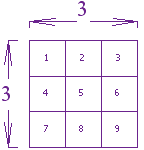How to Square A Number
To square a number, just multiply it by itself ...
Example: What is 3 squared?
| 3 Squared | = |  | = | 3 × 3 | = | 9 |
Note: we write down "3 Squared" as 32
(the little "2" means the number appears twice in multiplying)
Some More Squares
| 4 Squared | = | 42 | = | 4 × 4 | = | 16 |
| 5 Squared | = | 52 | = | 5 × 5 | = | 25 |
| 6 Squared | = | 62 | = | 6 × 6 | = | 36 |
Square Root
A square root goes the other direction:
3 squared is 9, so the square root of 9 is 3
| 3 |  | 9 |
The square root of a number is ...
... that special value that when multiplied by itself gives the original number.
The square root of 9 is ...
... 3, because when 3 is multiplied by itself you get 9.
 | Note: When you see "root" think "I know the tree, but what is the root that produced it?" In this case the tree is "9", and the root is "3". |
Here are some more squares and square roots:
 | ||
| 4 | 16 | |
| 5 | 25 | |
| 6 | 36 | |
Example: What is the square root of 25?
Well, we just happen to know that 25 = 5 × 5, so if you multiply 5 by itself (5 × 5) you will get 25.
So the answer is 5
The Square Root Symbol
| This is the special symbol that means "square root", it is sort of like a tick, and actually started hundreds of years ago as a dot with a flick upwards. It is called the radical, and always makes math look important! |
You can use it like this: ![]() (you would say "the square root of 9 equals 3")
(you would say "the square root of 9 equals 3")
More Advanced Topics Follow
You Can Also Square Negative Numbers
Have a look at this:
| If you square 5 you get 25: | 5 × 5 = 25 | |
| But you could also square -5 to get 25: | -5 × -5 = 25 | |
| (because a negative times a negative gives a positive) |
So the square root of 25 can be 5 or -5
There can be a positive or negative answer to a square root!
But when people talk about "the" square root they usually mean just the positive one.
And when you use the radical symbol √ it always means just the positive one.
Example: √36 = 6 (not -6)
Perfect Squares
The perfect squares are the squares of the whole numbers:
| 1 | 2 | 3 | 4 | 5 | 6 | 7 | 8 | 9 | 10 | 11 | 12 | 13 | 14 | 15 | etc | |
| Perfect Squares: | 1 | 4 | 9 | 16 | 25 | 36 | 49 | 64 | 81 | 100 | 121 | 144 | 169 | 196 | 225 | ... |
It is easy to work out the square root of a perfect square, but it is really hard to work out other square roots.
Example: what is the square root of 10?
Well, 3 × 3 = 9 and 4 × 4 = 16, so we can guess the answer is between 3 and 4.
- Let's try 3.5: 3.5 × 3.5 = 12.25
- Let's try 3.2: 3.2 × 3.2 = 10.24
- Let's try 3.1: 3.1 × 3.1 = 9.61
Very slow ... at this point, I get out my calculator and it says:
3.1622776601683793319988935444327
... but the digits just go on and on, without any pattern. So even the calculator's answer is only an approximation !
(Further reading: these kind of numbers are called surds which are a special type of irrational number)
A Special Method for Calculating a Square Root
There are many ways to calculate a square root, but my favorite method is an easy one which gets more and more accurate depending on how many times you use it:
a) start with a guess (let's guess 4 is the square root of 10)
b) divide by the guess (10/4 = 2.5)
c) add that to the guess (2.5+4=6.5)
d) then divide that result by 2, in other words halve it. (6.5/2 = 3.25)
e) now, set that as the new guess, and start at b) again
... so, our first attempt got us from 4 to 3.25
Going again (b to e) gets us: 3.163
Going again (b to e) gets us: 3.1623
And so, after 3 times around the answer is 3.1623, which is pretty good, because:
3.1623 x 3.1623 = 10.00014
This is fun to try - why not use it to try calculating the square root of 2?